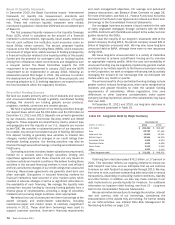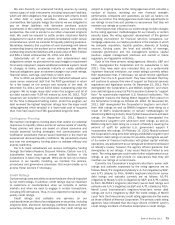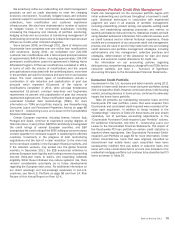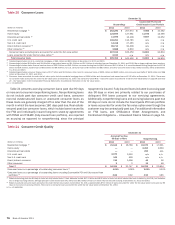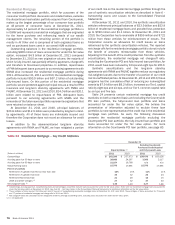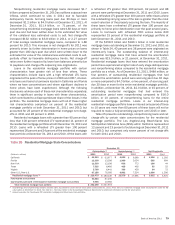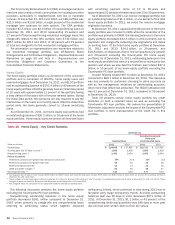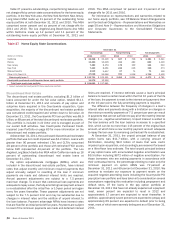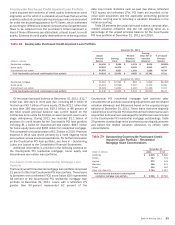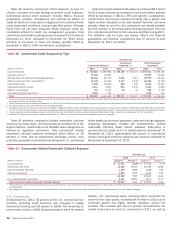Bank of America 2011 Annual Report Download - page 82
Download and view the complete annual report
Please find page 82 of the 2011 Bank of America annual report below. You can navigate through the pages in the report by either clicking on the pages listed below, or by using the keyword search tool below to find specific information within the annual report.
80 Bank of America 2011
The Community Reinvestment Act (CRA) encourages banks to
meet the credit needs of their communities for housing and other
purposes, particularly in neighborhoods with low or moderate
incomes. At December 31, 2011 and 2010, our CRA portfolio was
$12.5 billion and $13.8 billion, or eight percent of the residential
mortgage loan balances for both periods. The CRA portfolio
included $2.5 billion and $3.0 billion of nonperforming loans at
December 31, 2011 and 2010 representing 15 percent and
17 percent of total nonperforming residential mortgage loans. Net
charge-offs related to the CRA portfolio were $732 million and
$857 million for 2011 and 2010, or 19 percent and 23 percent
of total net charge-offs for the residential mortgage portfolio.
For information on representations and warranties related to
our residential mortgage portfolio, see Off-Balance Sheet
Arrangements and Contractual Obligations – Representations and
Warranties on page 50 and Note 9 – Representations and
Warranties Obligations and Corporate Guarantees to the
Consolidated Financial Statements.
Home Equity
The home equity portfolio makes up 20 percent of the consumer
portfolio and is comprised of HELOCs, home equity loans and
reverse mortgages. As of December 31, 2011, our HELOC portfolio
had an outstanding balance of $103.4 billion or 83 percent of the
home equity portfolio. HELOCs generally have an initial draw period
of 10 years with approximately 11 percent of the portfolio having
a draw period of five years with a five-year renewal option. During
the initial draw period, the borrowers are only required to pay the
interest due on the loans on a monthly basis. After the initial draw
period ends, the loans generally convert to 15-year amortizing
loans.
As of December 31, 2011, our home equity loan portfolio had
an outstanding balance of $20.2 billion, or 16 percent of the home
equity portfolio. Home equity loans are almost all fixed-rate loans
with amortizing payment terms of 10 to 30 years and
approximately 52 percent of these loans have 25 to 30-year terms.
As of December 31, 2011, our reverse mortgage portfolio had
an outstanding balance of $1.1 billion, or one percent of the total
home equity portfolio. In 2011, we exited the reverse mortgage
origination business.
At December 31, 2011, approximately 88 percent of the home
equity portfolio was included in CRES while the remainder of the
portfolio was primarily in GWIM. Outstanding balances in the home
equity portfolio decreased $13.3 billion in 2011 primarily due to
paydowns and charge-offs outpacing new originations and draws
on existing lines. Of the total home equity portfolio at December
31, 2011 and 2010, $24.5 billion, or 20 percent, and
$24.8 billion, or 18 percent, were in first-lien positions (22 percent
and 20 percent excluding the Countrywide PCI home equity
portfolio). As of December 31, 2011, outstanding balances in the
home equity portfolio that were in a second-lien or more junior-lien
position and where we also held the first-lien loan totaled $37.2
billion, or 33 percent, of our home equity portfolio excluding the
Countrywide PCI loan portfolio.
Unused HELOCs totaled $67.5 billion at December 31, 2011
compared to $80.1 billion at December 31, 2010. This decrease
was due primarily to customers choosing to close accounts as
well as line management initiatives on deteriorating accounts,
which more than offset new production. The HELOC utilization rate
was 61 percent at December 31, 2011 compared to 59 percent
at December 31, 2010.
Table 26 presents certain home equity portfolio key credit
statistics on both a reported basis as well as excluding the
Countrywide PCI loan portfolio. We believe the presentation of
information adjusted to exclude the impact of the Countrywide PCI
loan portfolio is more representative of the credit risk in this
portfolio.
Table 26
(Dollars in millions)
Outstandings
Accruing past due 30 days or more (1)
Nonperforming loans (1)
Percent of portfolio
Refreshed combined LTV greater than 90 but less than 100
Refreshed combined LTV greater than 100
Refreshed FICO below 620
2006 and 2007 vintages (2)
Net charge-off ratio (3)
Home Equity – Key Credit Statistics
December 31
Reported Basis
2011
$ 124,699
1,658
2,453
10%
36
13
50
3.42
2010
$ 137,981
1,929
2,694
11%
34
14
50
4.65
Excluding Countrywide
Purchased
Credit-impaired Loans
2011
$ 112,721
1,658
2,453
11%
32
12
46
3.77
2010
$ 125,391
1,929
2,694
11%
30
12
47
5.10
(1) Accruing past due 30 days or more includes $609 million and $662 million and nonperforming loans includes $703 million and $480 million of loans where we serviced the underlying first-lien at
December 31, 2011 and 2010.
(2) These vintages of loans have higher refreshed combined LTV ratios and accounted for 54 percent and 57 percent of nonperforming home equity loans at December 31, 2011 and 2010. These
vintages of loans accounted for 65 percent and 66 percent of net charge-offs in 2011 and 2010.
(3) Net charge-off ratios are calculated as net charge-offs divided by average outstanding loans.
The following discussion presents the home equity portfolio
excluding the Countrywide PCI loan portfolio.
Nonperforming outstanding balances in the home equity
portfolio decreased $241 million compared to December 31,
2010 driven primarily by charge-offs and nonperforming loans
returning to performing status which together outpaced
delinquency inflows, which continued to slow during 2011 due to
favorable early stage delinquency trends. Accruing outstanding
balances past due 30 days or more decreased $271 million in
2011. At December 31, 2011, $1.1 billion, or 43 percent, of the
nonperforming home equity portfolio was 180 days or more past
due and had been written down to their fair values.




